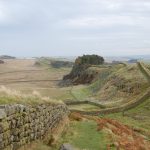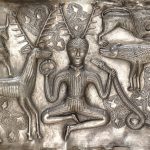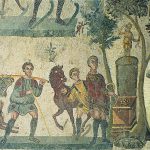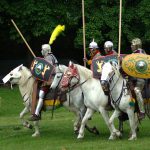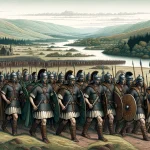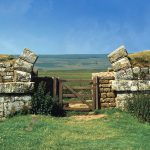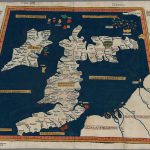Castleford (Lagentium) Roman Fort
Flavian Auxiliary Fort (AD 69–96)
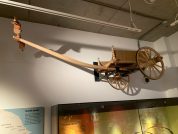
The Roman fort at Castleford was called Lagentium. The fort underlies the modern town centre of Castleford in West Yorkshire. The fort was situated on the south bank of the River Aire, just downstream of its confluence with the River Calder, at the point where the stream was forded by the main Roman road running between the Colonies at Lindum (Lincoln, Lincolnshire) and Eburacum (York, Yorkshire). To conquer the Brigantes the Romans built a network of roads and forts in the 70s AD. One of the forts was at Castleford, they replaced this fort with another smaller one.
Roman Castleford was an important manufacturing place that specialised in metalwork, making small items – especially objects decorated with enamel. Skilled craftsmen made spoon, brooches and water canteens. These objects were often army equipment or souvenirs.
Caslteford was an important trade and communications centre, as travellers and traders could come by road or by sailing up the Aire. Imported pottery was stored in Castleford warehouses, and imperial messengers stopped here to rest and charge their horses. It was also the centre for farming in the area. Over time farming became more intensive and food was exported to the continent.
Classical References to Castleford (Lagentium) Roman Fort
The Roman name for Castleford is mentioned in only one (out of four) of the main classical geographies, but the Antonine Itinerary makes up for this by listing it twice. The town appears in the middle of the Fifth Itinerary as Legeolio, sixteen miles from Danum (Doncaster, South Yorkshire) and twenty-one miles from Eburacum (York, North Yorkshire). The town is also mentioned in Iter VIII “The Route from Eburacum to Londinium,” this time at the top of the itinerary as Lagecio, where again, it is listed twenty-one miles from York and sixteen from Doncaster. The commonly accepted name is Lagentium. It is possible that the Roman name should be translated as “The Place of the Bottles”, from the Latin lagenae ‘bottles, flasks’, especially since a Roman glass-making industry has been identified at Castleford (vide infra).
The Roman Road Station
The Roman road through Castleford is known locally as ‘Roman Ridge’, and runs almost due north over the river almost eight miles (13km) before veering obliquely to the north-east towards the minor settlement at Calcaria (Tadcaster, North Yorkshire), at a point where the road runs under the modern A1 trunk road at Nut Hill (SE433391), just south of its junction with the A64(T). In the opposite direction, the road appears to have left the immediate vicinity of the fort in a southerly direction and then veered towards the south-east perhaps on the outskirts of North Featherstone two miles to the south, or possibly between North Featherstone and Pontefract Park race-course; the exact route is unknown.
… exploration on the site of demolished houses in Welbeck Street located an industrial area in the vicus outside the south gate of the fort. Many glass wasters were found, all unstratified. Pottery suggests occupation from the mid-2nd century.
The Gods of Roman Castleford
There are only five inscriptions on stone recorded at Lagentium, three of which are milestones (vide infra), the remaining two both altarstones. The latest altarstone was found at Castleford in 1983 and subsequently included in the RIB (628.a; Britannia xiv, 1983, p.337, no.11). The text reads simply NYMPIS or “To the Nymphs”, evidently dedicated to the local water deities. The text of the only other Castleford altarstone is shown and translated below.
RIB 628 - Altar dedicated to Victoria Brigantia
To the goddess Victoria Brigantia Aurelius Senopianus dedicated this altar.
TORIAE
BRIGANT
A D AVR S
ENOPIANVS
For Victoria Brigantia see RIB 627.
Roman Milestones from the Castleford Area
Milestone Found ½ mile South of Castleford Inscribed on Two Faces (RIB 2273/4)
RIB 2273 - Milestone of Decius
For the Emperor Caesar Gaius Messius Quintus Decius Pius Felix Augustus, and Gaius Messius Quintus Etruscus, (most noble) Caesar.
G M Q
DECIO
P F AVG
ET G M
Q ETRV
SCO C
AESAR
a.d. 250-spring 251 (as the younger Decius is not yet Augustus).
RIB 2274 - Milestone of Gallus and Volusian
For the Emperor-Caesars Vibius Gallus and Gaius Veldumnianus Volusianus, (each) Pius Felix Augustus: from Eboracum 22 miles.
O GALLO ET G V
VOLVSIA
NO P F
AVG EB
M P XXII
Cut at the other end of RIB 2273.Gallus and Volusian, A.D. 251-3.
A couple of important milestones or honorific pillars have been unearthed at or near Castleford, one of which was only in use for a couple of years before being reinscribed and rededicated to another emperor (RIB 2273/4 supra). These stones are particularly useful not only as distance indicators between neighbouring Roman towns which are sometimes mentioned by name, but also frequently provide confirmation of otherwise obscure imperial titles and other appellations.
RIB 2275 - Milestone of Florian
For the Emperor Caesar Marcus Annius Florianus Pius Felix Augustus.
MAR ANNIO
FLORIANO
P F AVG
Florian, A.D. 276.
IMP C (M) ANNI (OFLO) [RIANO P F INV AVG M P E XXVI]¹
“For Imperator Caesar Marcus Annius Florianus² [Pius Felix Invictus Augustus. Twenty-six miles to/from Eburacum].”
(RIB 2275a?;³ dated: 276AD)
- Restoration of the text supplied by Mr. Eric Houlder.
- The emperor Florianus (see note#1 RIB 2275, above).
- The RIB designation has yet to be confirmed by Dr. R. Tomlin.
Visiting Castleford Forum Museum
Castleford’s Roman past is preserved and displayed at the Castleford Forum Museum (now part of Wakefield Museums and Castles). The museum features archaeological finds from Lagentium, the Roman fort and settlement, including pottery, coins, and building remains, showcasing the town’s rich Roman history.
References for Lagentivm
- Chronicle of the Roman Emperors by Chris Scarre (Thames & Hudson, London, 1995);
- The Roman Inscriptions of Britain by R.G. Collingwood and R.P. Wright (Oxford 1965).
Roman Roads near Lagentivm
SE (11) to Bvrghwallis Itinera V/VIII: N (13) to Calcaria (Tadcaster, North Yorkshire) Itinera V/VIII: SSE (16) to Danvm (Doncaster, South Yorkshire) Roman Ridge: N (13) to Newton Kyme (North Yorkshire)
Sites near Castleford (Lagentium) Roman Fort
- Barwick-in-Elmet (12 km)
Iron Age Hillfort - Roall Roman Fort (14 km)
Flavian Auxiliary Fort (AD 69–96) - Burghwallis Roman Fort (17 km)
Auxiliary Fort - Tadcaster (Calcaria) Roman Settlement (18 km)
Minor Settlement - Newton Kyme Vicus (19 km)
Probable Settlement - Newton Kyme Temporary Camp (20 km)
Marching or Temporary Camp - Newton Kyme Roman Fort (20 km)
Vexillation Fort - Staincross Common (20 km)
Temple Or Shrine - Adel (21 km)
Major Settlement - Drax (26 km)
Roman-Building
